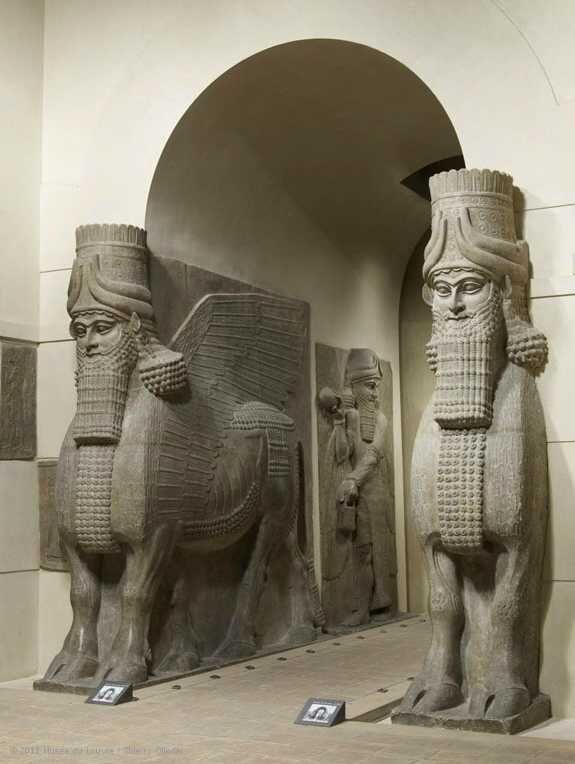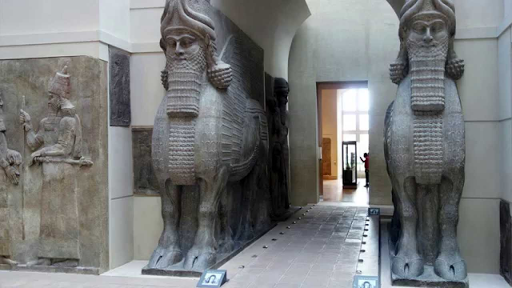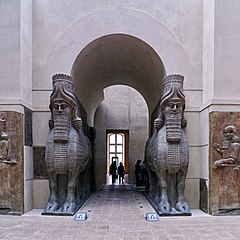What were the most common themes in Assyrian art. An enormous Winged Lamassu from ancient Assyria at the Palace of Sargon II.
The Collection Ancient Near Eastern Art Human-headed winged lion lamassu ca.

. Diocletian and constantine paved the way for foreign invasion by dividing the empire creating administrative. Where were the lamassu sculptures originally displayed. In the Assyrian mythology there were human headed winged bullslions that were protective genies.
Sargons palace gudeas lagash ashurbanipals palace ziggurat at ur. It is 164cm tall and 343cm long which is larger than an actual average lion. Which work has a king approaching the god.
They were represented as double-aspect figures on corners in high relief. What ethnic group is credited with the first system of writing known to man. The correct answer that would best complete the given statement above would be option b.
Prominent pairs of lamassu were typically placed at entrances in palaces facing the street and also internal courtyards. The Lamassu sculptures were recovered from where. From what we can tell it seems that these sculptures were believed to protect the palace and king from evil supernatural forces as well.
Backstory The lamassu in museums today including the Louvre shown in our video as well the British Museum The Metropolitan Museum of Art and National Museum of Iraq in Baghdad and others came from various ancient Assyrian sites located in modern-day Iraq. Towering over us each was. The Ziggurat at Ur was a fortress funerary monument palace temple platform Where were the Lamassu sculptures originally displayed.
You can see them at Gate of All Nations at Persepolis in Iran the British Museum in London the Louvre in Paris the National Museum of Iraq in Baghdad the Metropolitan Museum of Art in New York and the University of Chicago Oriental Institute. They were double-aspect figures on corners in high relief a type earlier found in Hittite art. A Sargons palace b Gudeas Lagash c Ashurbanipals palace d Ziggurat at Ur Which of the following played an important role in the shaping of modern art.
It was used at palace entrances and placed strategically by magicians to protect from evil. Babylonian protective demon with a bulls body eagles wings and a human head. These sculptures were excavated by P-E.
The Lamassu seen from the side from the palace Sargon II r. The most famous colossal statues of Lamassu have been excavated at the sites of the Assyrian capitals established by King Assurnasirpal II reigned 883 859 BCE and King Sargon II reigned 721 705 BCE. Human-headed Winged Lion is a raised relief sculpture of a Lamassu with the body of a lion made of gypsum alabaster.
883-612 large monumental bulls often with wings and always with human heads were placed as gateway guardians at the entrances of royal palaces like Khorsabad and Nineveh. Lamassu bull-man Lamassu. It was originally made for Hatshepsuts funerary temple at Deir el-Bahri which is a complex of temples dedicated to pharaohs of her family.
The Assyrians envisioned a protective spirit that was part bull and part human and sometimes part eagle. An American professor named Michael Rakowitz was commissioned to recreate this Lamassu sculpture and it is now displayed in Trafalgar Square in London. Assyrian On view at The Met Fifth Avenue in Gallery 401 From the ninth to the seventh century BC the kings of Assyria ruled over a vast empire centered in northern Iraq.
Click to see full answer Furthermore where were the lamassu sculptures originally displayed. The most famous colossal statues of Lamassu have been excavated at the sites of the Assyrian capitals created by King Assurnasirpal II reigned 883 859 BC and King Sargon II reigned 721 705 BC. The Lamassu sculptures were recovered from where.
Sargons palace Which is the oldest site for town planning. In some cases the lamassu statues were accompanied by. The winged beasts from Nimrud in Iraq the ancient city of Kalhu also became quite famous when Lamassu there were ruined in 2015.
The original is located at the Oriental Institute at the University of Chicago. The first change was the capital was moved to Dur Sharrukin present day Khorsabad and second the Lamassu was presented on a bulls body compared to a lions and seems to be slightly smiling. It was discovered at the site of ancient Khorsabad around 1930 and dates to the reign of Sargon II 721-705 BC.
These massive sculptures served as symbolic guards of Assyrian kings domain being placed at the entrance to both the city and palace gateways See Collins 2008 72. 721-705 BCE Part of a collection at the Louvre in Paris France. We were now at the ground level of the original Assyrian palace and the lamassu which were thought of as protective deities stood guard either side of an entrance way.
Catal Huyuk Which is NOT true in regards to Ancient Near Eastern ethnic groups. Extensive architectural remains Which was NOT a scene on the sarcophagus of Junius Bassus. This replica was made with 10000 Iraqi date syrup cans and serves as a symbol of bright colors in the dark gray area of London.
Where were the Lamassu sculptures originally displayed. Assyrian sculpture typically placed prominent pairs of lamassu at entrances in palaces facing the street and also internal courtyards.

Lamassu Symbol For Protection Indrosphere

Lamassu History 2701 Wiki Fandom

Lamassu From The Citadel Of Sargon Ii Video Khan Academy

Lamassus At The Louvre Thatmuse

25 Lamassu From The Citadel Of Sargon Ii Dur Sharrukin Modern Iraq Ap Art History

Lamassu Backstory Article Assyrian Khan Academy
Human Headed Winged Lion Lamassu Assyrian Neo Assyrian The Metropolitan Museum Of Art


0 comments
Post a Comment